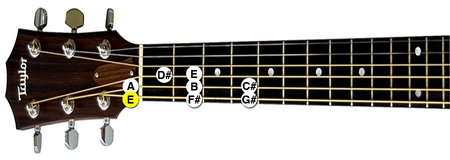Now, we will learn about a few of the most common scales and how to use them to improve your guitar playing. They will help strengthen your fingers, improve your hand-eye coordination, and greatly improve your ability to learn more advanced guitar techniques.
Note: Although the diagrams and instructions below show how to play each of these scales in the key of E, they can all be played in any key you want. At the bottom of each section you will find instructions on how to play each scale in the key of your choice.
The Chromatic Scale
- For our first scale, we will start with the most basic scale in music: The Chromatic Scale. The chromatic scale is a series of twelve successive half-steps.1 While this scale might not seem very musically interesting to the ear, it is still one of the most important scales to know (as it contains the basic elements of every other scale). Here's how to play the Chromatic scale in the key of E.
- Start by playing the 6th string "Open."
- Next, take the index finger on your fretting hand and hold down the first fret on the 6th string. Pluck the 6th string again.
- Using your middle finger, hold down the second fret of the 6th string and play it again.
- Use your ring finger to hold down the third fret and play the string again.
- Use your pinkie finger to hold down the fourth fret and play it once more.
- Repeat these steps for each of the subsequent strings (except the 3rd string & only play the first three frets on that one).
Other Keys
- In order to play the Chromatic scale in other keys, follow this simple formula, starting on the root note of your chosen key (H = 1 Half-Step or 1 Fret and W = Whole Step or 2 Frets):
Root - H - H - H - H - H - H - H - H - H - H - H - H - Root
The Major Scale
- The Major Scale is one of the most important and useful scales to know when playing guitar. It is the corner stone of western music and is made up of 7 notes.2 It has a bright, upbeat quality (much like a Major chord) and can be a great tool for soloing in songs that are in a Major key. Here is how to play the Major scale in the key of E:
- Play the 6th string "Open"
- Play the 6th string, 2nd fret
- Play the 6th string, 4th fret
- Play the 5th string "Open"
- Play the 5th string, 2nd fret
- Play the 5th string, 4th fret
- Play the 4th string, 1st fret
Other Keys
- In order to play the Major scale in other keys, follow this simple formula (starting on the root note of your chosen key):

- Root - W - W - H - W - W - W - H - Root
The Minor Scale
- The Minor scale has a darker, more moody quality to it than the Major scale (much like a Minor chord) and can be a useful soloing tool for songs that have a similar quality to them. Here is how to play the Minor scale in the key of E:
- Play the 6th string "Open"
- Play the 6th string, 2nd fret
- Play the 6th string, 3rd fret
- Play the 5th string "Open"
- Play the 5th string, 2nd fret
- Play the 5th string, 3rd fret
- Play the 4th string "Open"
Other Keys
- In order to play the Minor scale in other keys, follow this simple formula (starting on the root note of your chosen key):
Root - W - H - W - W - H - W - W - Root
Check out th next post for more on scales.

very nice work!
ReplyDelete